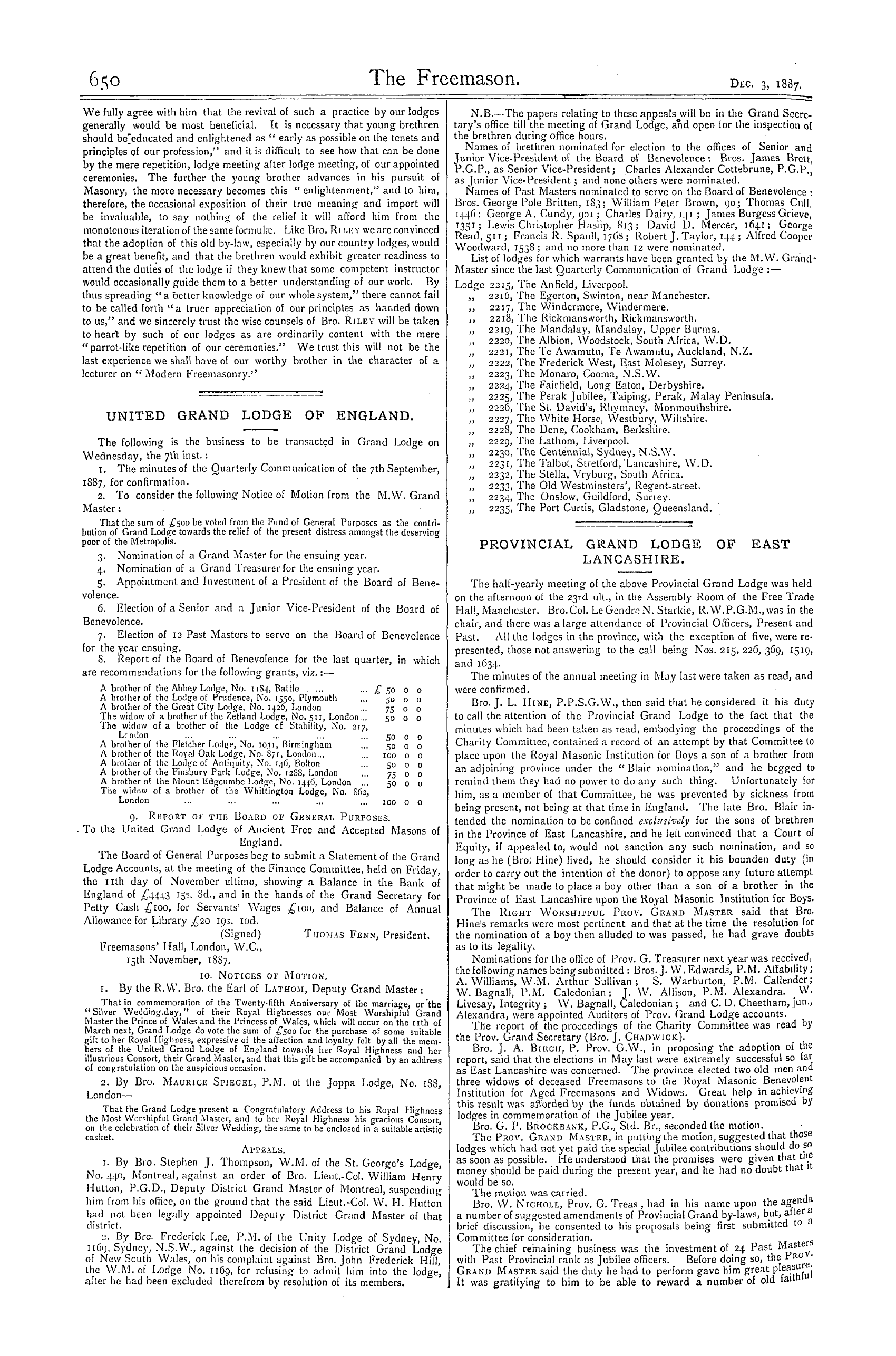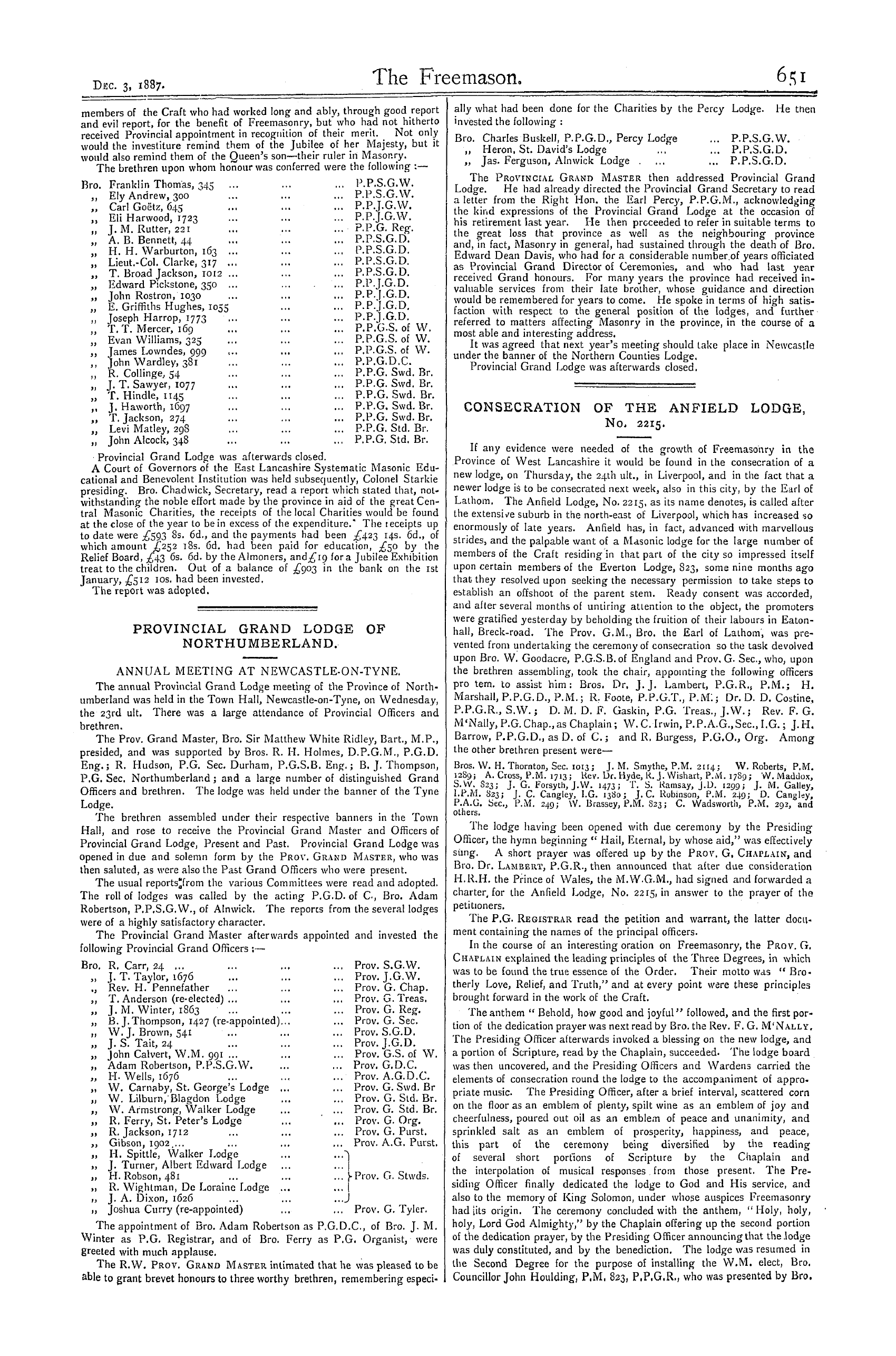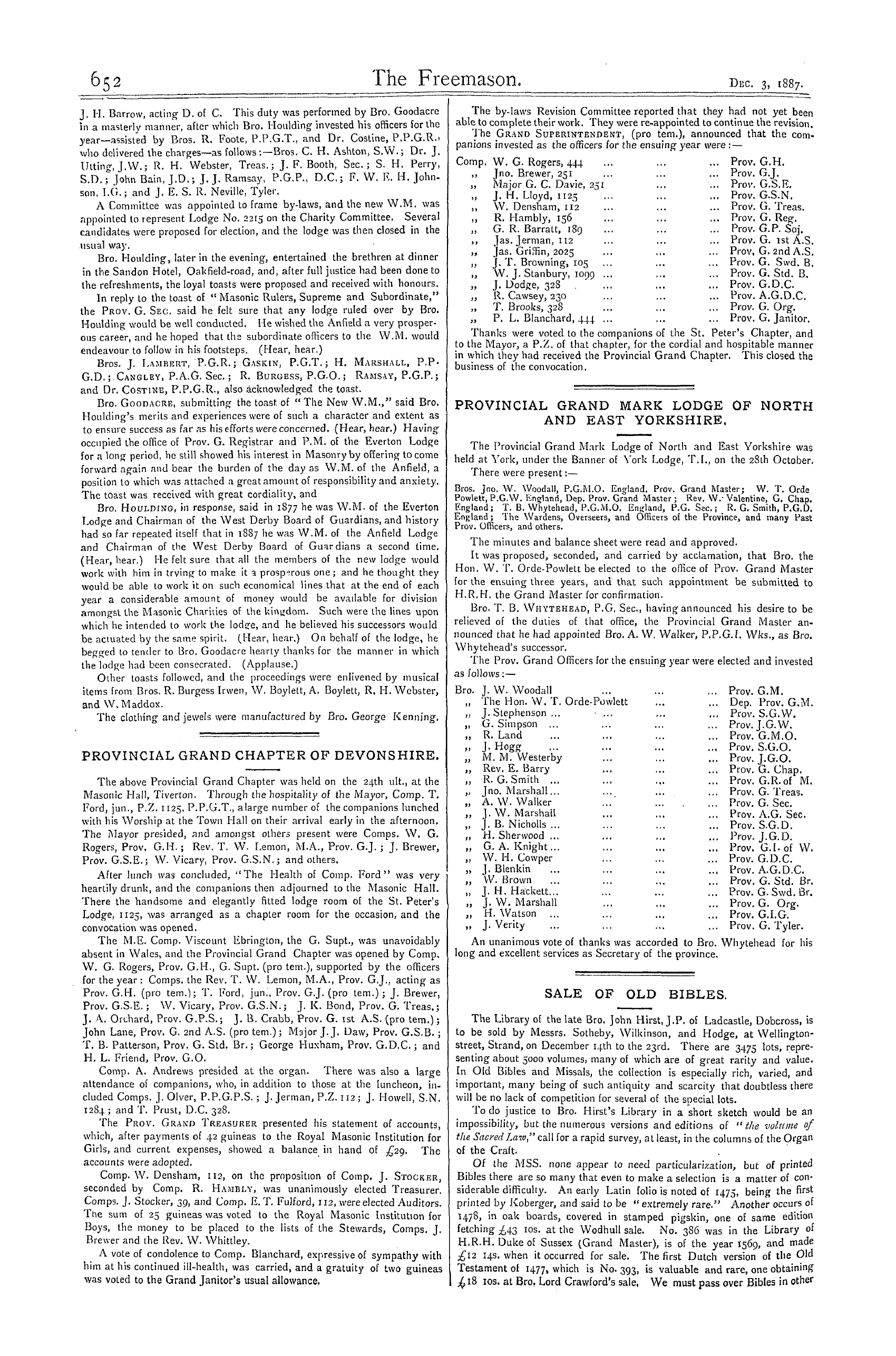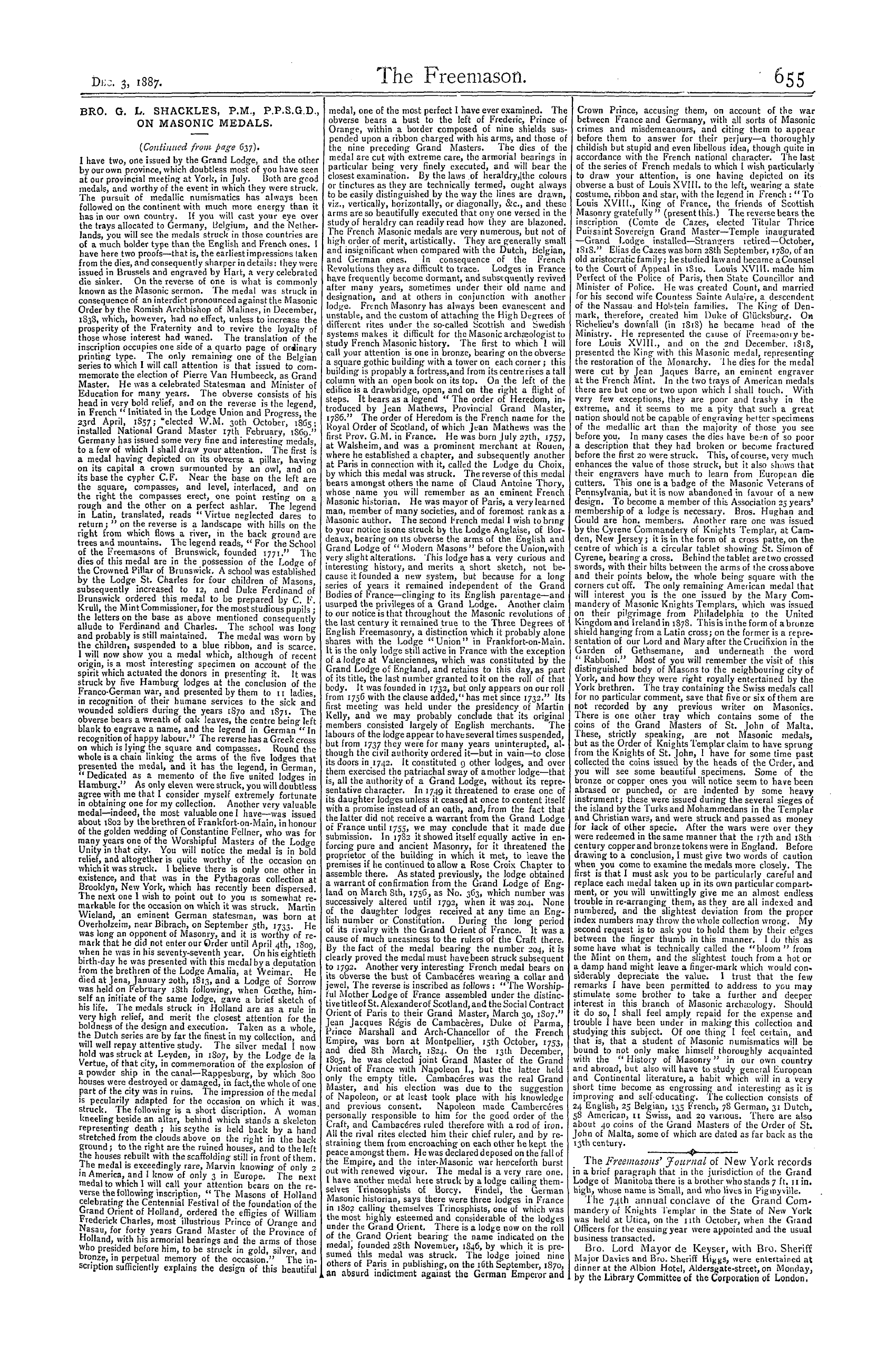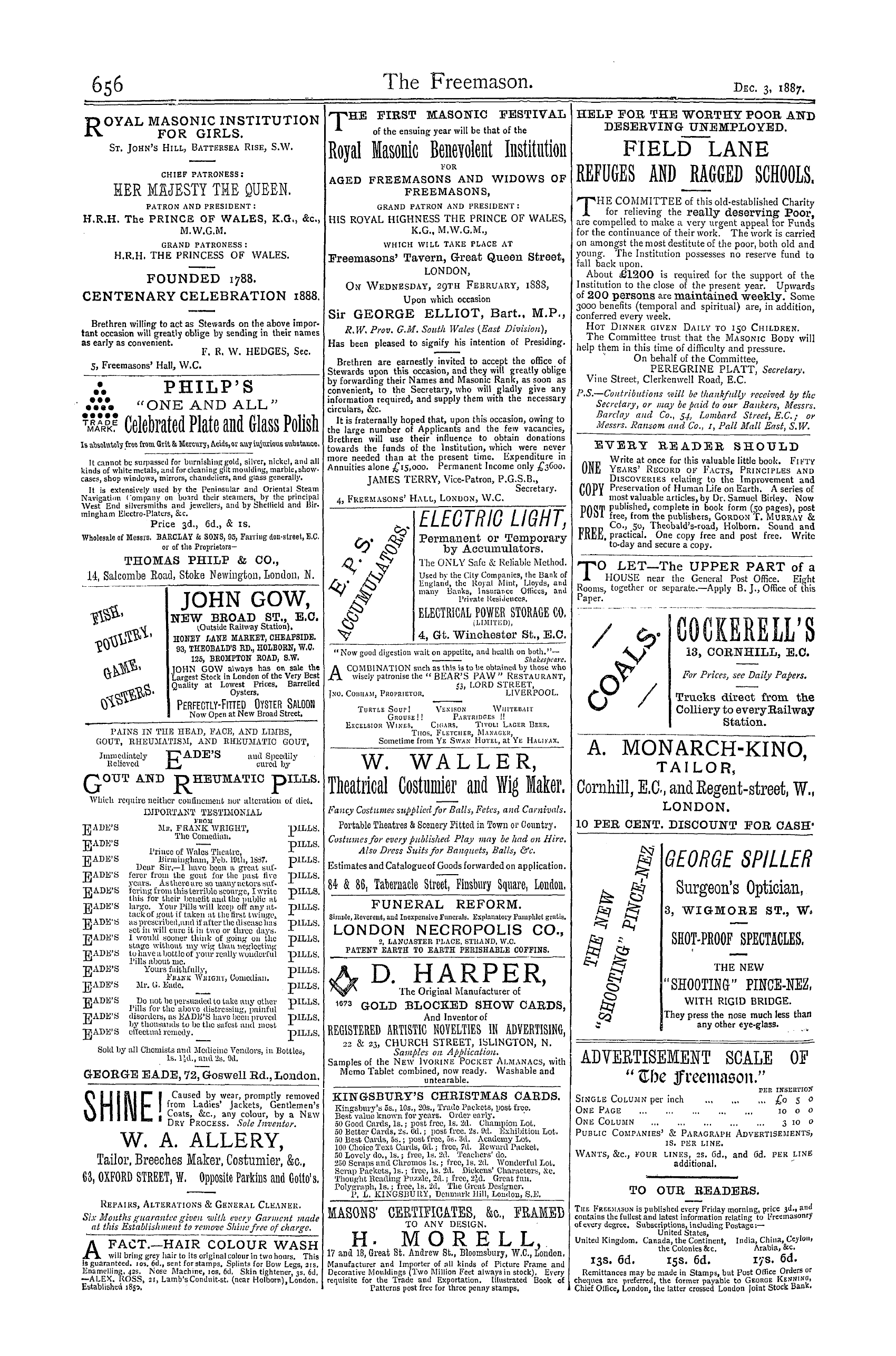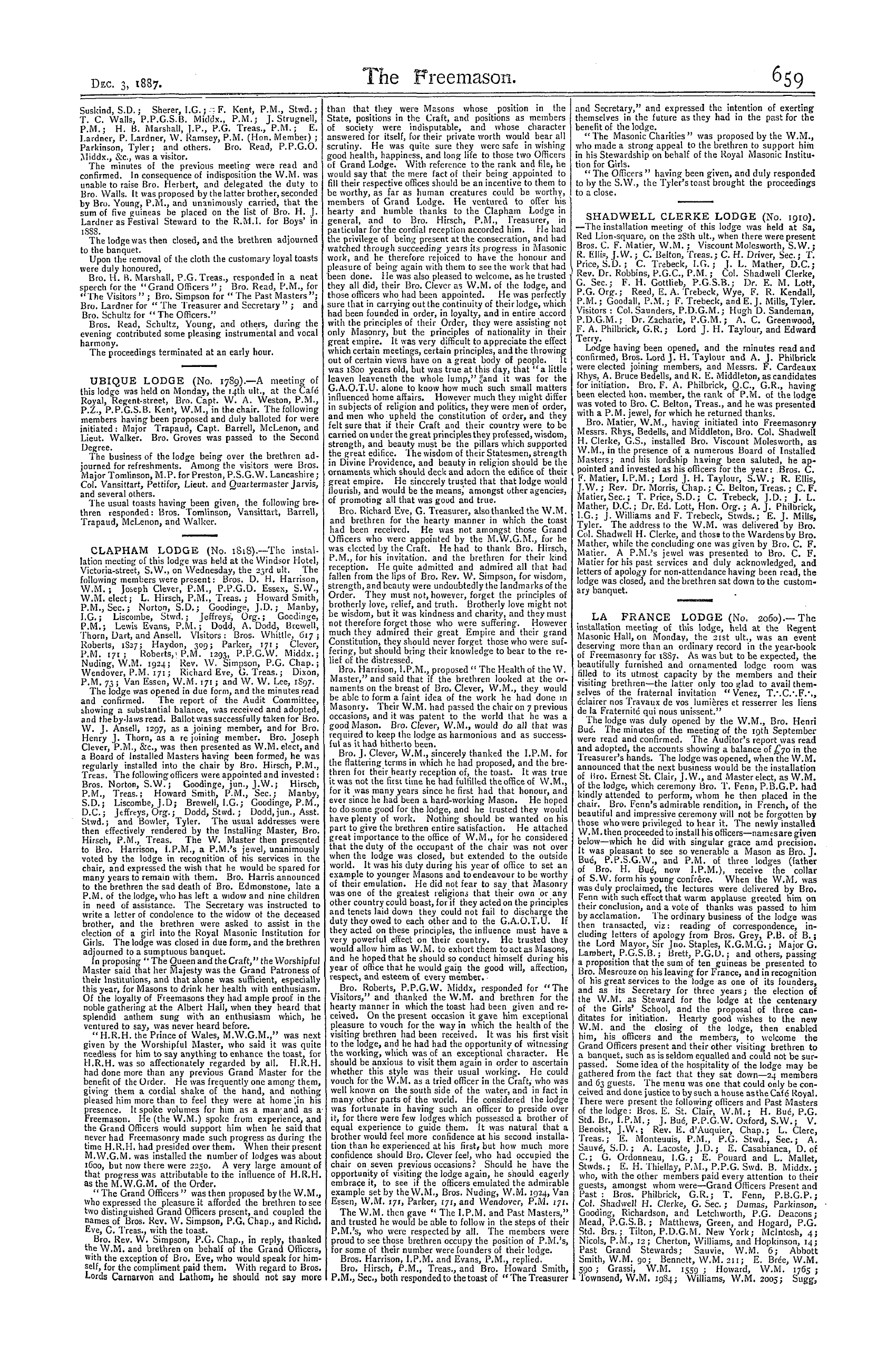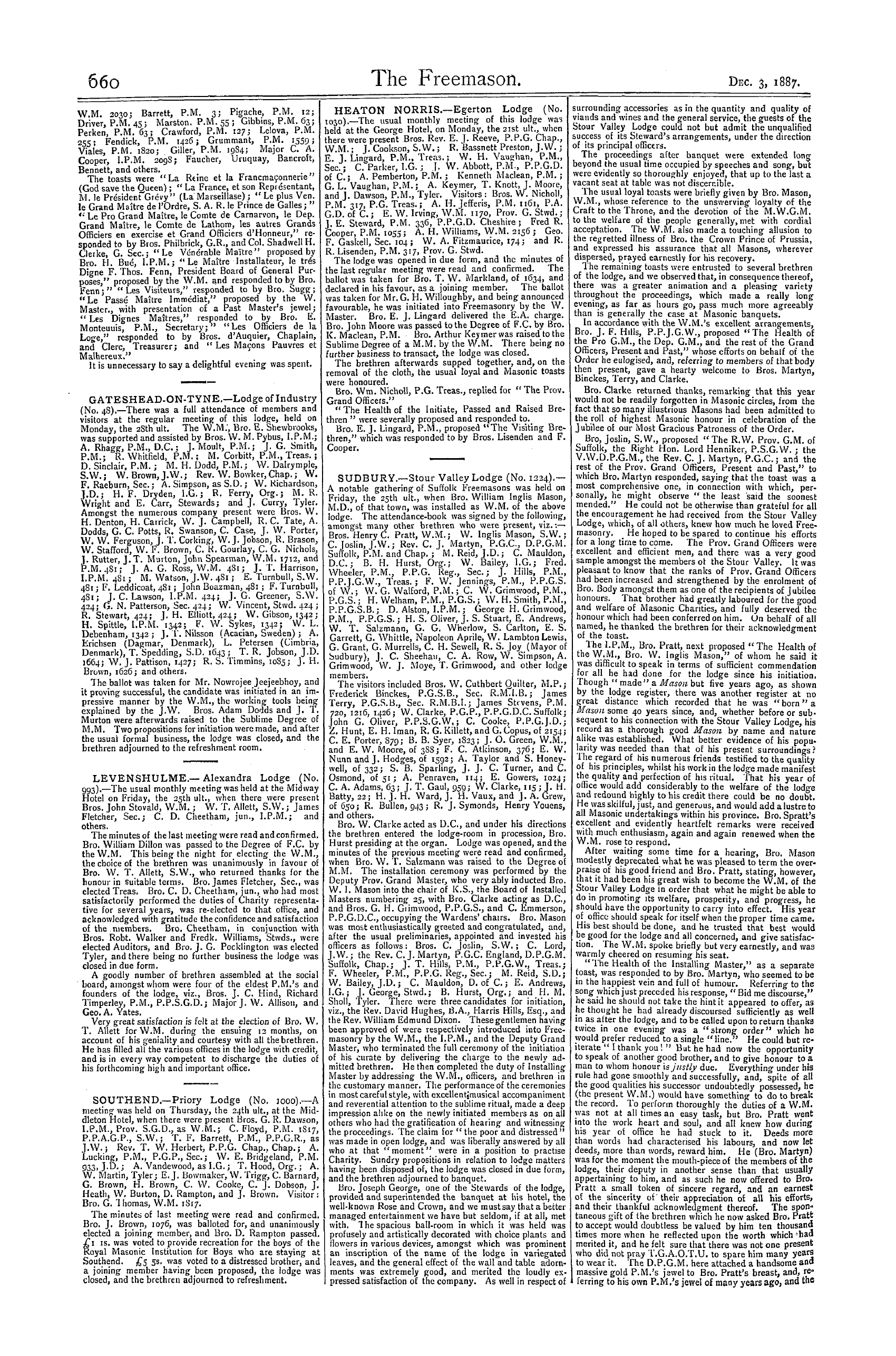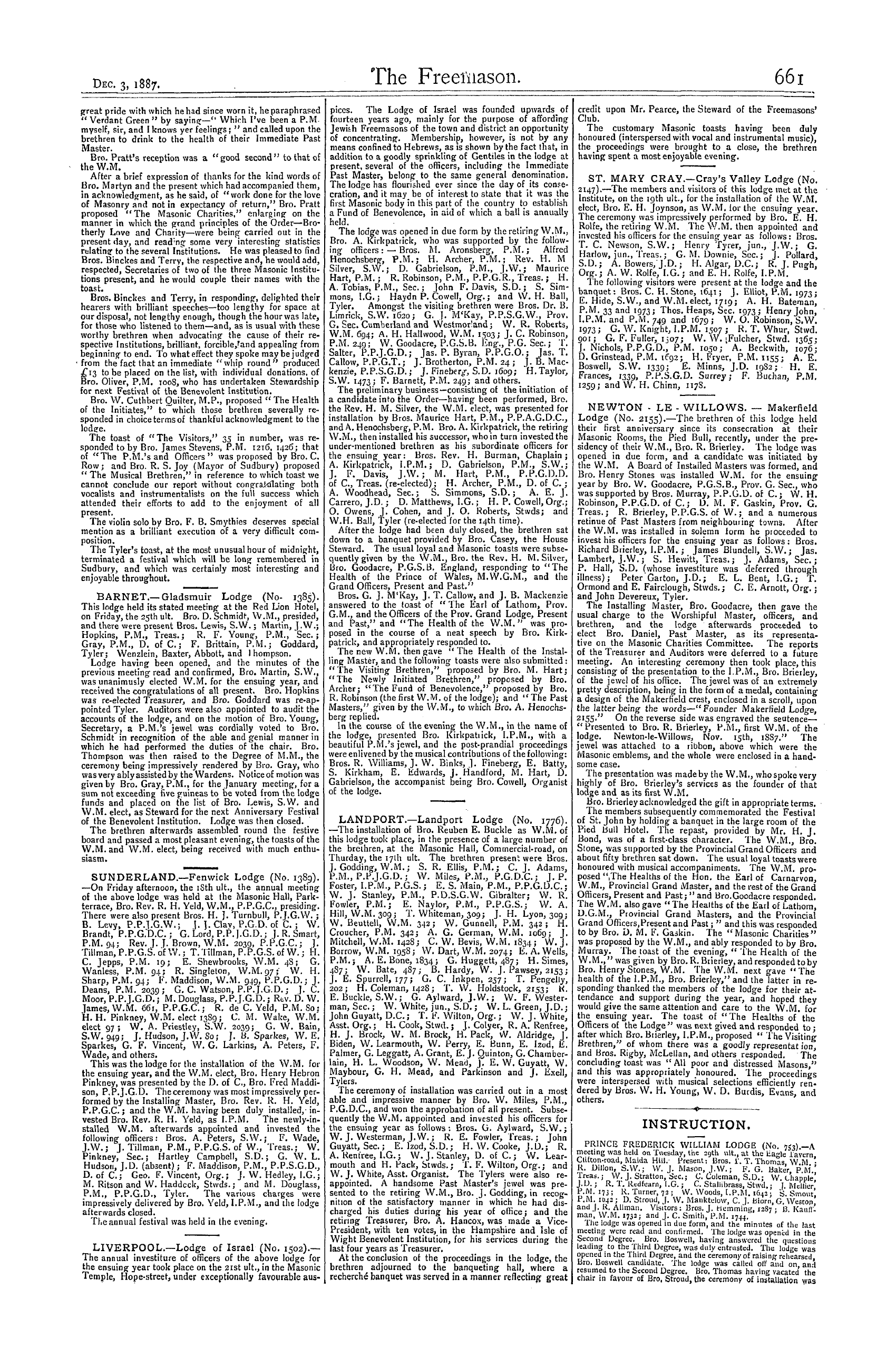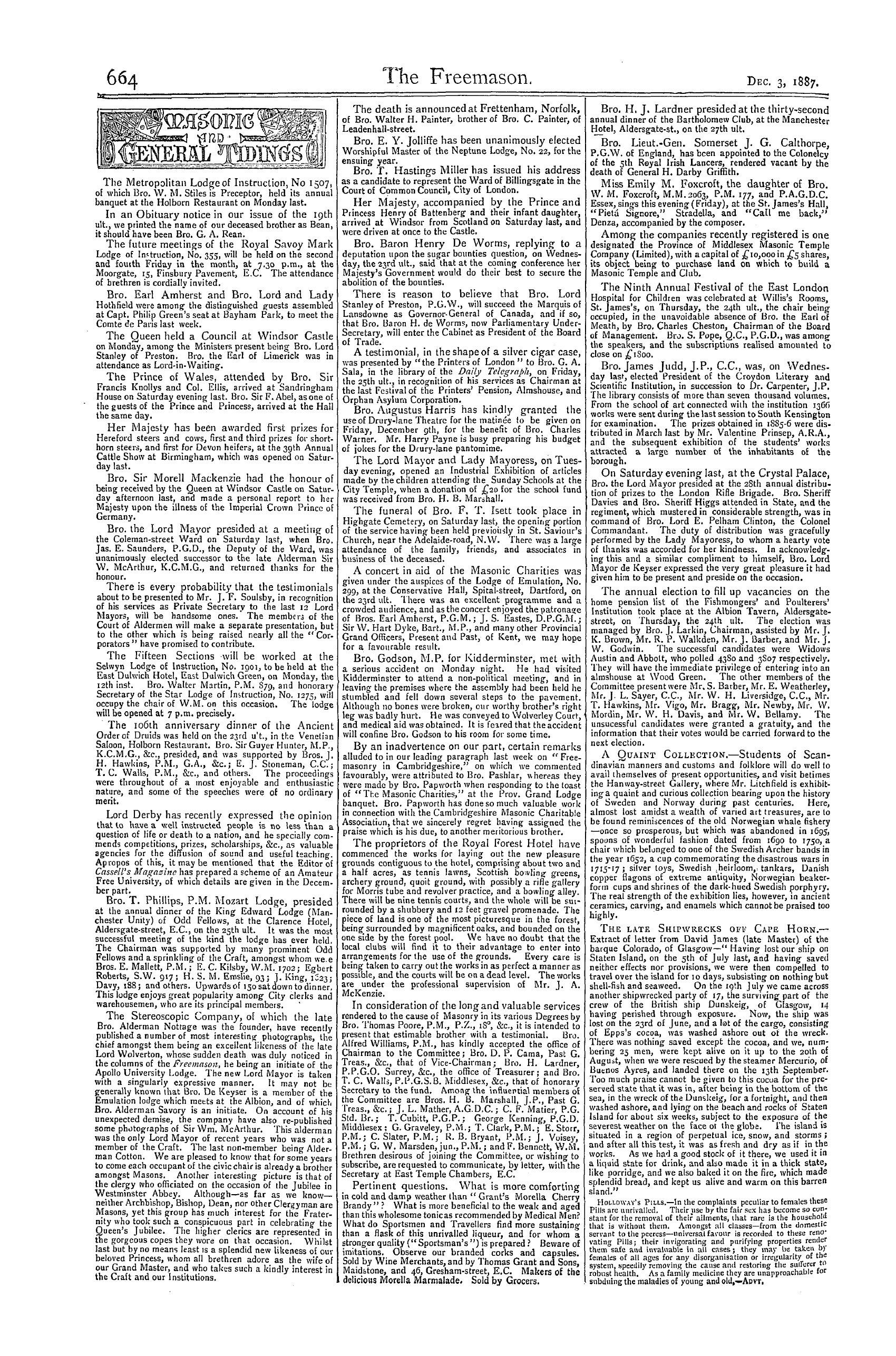Note: This text has been automatically extracted via Optical Character Recognition (OCR) software.
Bro. G. L. Shackles, P.M., P.P.S.G.D., On Masonic Medals.
BRO . G . L . SHACKLES , P . M ., P . P . S . G . D ., ON MASONIC MEDALS .
{ Continued from page 637 ) . I have two , one issued by the Grand Lodge , and the other by our own province , vvhich doubtless most of you have seen at our provincial meeting at York , in July . Both are good medals , and worthy of the event in vvhich they were struck . The pursuit of medallic numismatics has always been followed on the continent vvith much more energy than it
has in our own country . If you will cast your eye over the trays allocated to Germany , Belgium , and the Netherlands , you will see the medals struck in those countries are of a much bolder type than the English and French ones . I have here two proofs—that is , the earliest impressions taken from the dies , and consequently sharper in details : Ihey were issued in Brussels and engraved by Hart , a very celebrated
die sinker . On the reverse of one is vvhat is commonly known as the Masonic sermon . The medal was struck in consequence of an interdict pronounced against the Masonic Order by the Romish Archbishop of Malines , in December , 1838 , vvhich , however , had no effect , unless to increase the prosperity of the Fraternity and to revive the loyalty of those whose interest had waned . The translation of the
inscription occupies one side of a quarto page of ordinary printing type . The only remaining one of the Belgian series to which I will call attention is that issued to commemorate the election of Pierre Van Humbeeck , as Grand Master . He vvas a celebrated Statesman and Minister of Education for many years . The obverse consists of his head in very bold relief , and on the reverse is the legend ,
in French " Initiated in the Lodge Union and Progress , the 23 rd April , 1 S 57 ; " elected W . M . 30 th October , 1865 ; installed National Grand Master 17 th February , 1 S 69 . " Germany has issued some very fine and interesting medals , to a few of vvhich I shall draw your attention . The first is a medal having depicted on its obverse a pillar , havino on its capital a crown surmounted by an owl , and on
its base the cypher C . F . Near the base on the left are the square , compasses , and level , interlaced , and on the right the compasses erect , one point resting on a rough and the other on a perfect ashlar . The legend in Latin , translated , reads " Virtue neglected dares to return ; " on the reverse is a landscape vvith hills on the right from vvhich flows a river , in the back ground are
trees and mountains . The legend reads , " For the School of the Freemasons of Brunswick , founded 1771 . " The dies of this medal are in the possession of the Lodge of the Crowned Pillar of Brunswick . A school was established by the LodgeSt . Charles for four children of Masons , subsequently increased to 12 , and Duke Ferdinand of Brunswick ordered this medal to be prepared by C . F .
Krull , the Mint Commissioner , for the most studious pupils ; the letters on the base as above mentioned consequently allude to Ferdinand and Charles . The school was long and probably is still maintained . The medal vvas worn by the children , suspended to a blue ribbon , and is scarce . I will novv show you a medal vvhich , although of recent origin , is a most interesting specimen on account of the
spirit which actuated the donors in presenting it . It vvas struck by five Hamburg lodges at the conclusion of the Franco-German war , and presented by them to 11 ladies , in recognition of their humane services to the sick and wounded soldiers during the years 1 S 70 and 1871 . The obverse bears a wreath of oak leaves , the centre being left blank to engrave a name , and the legend in German "In
recognition of happy labour . " The reverse has a Greek cross on vvhich is lying the _ square and compasses . Round the whole is a chain linking the arms of the five lodges that presented the medal , and it has the legend , in German , " Dedicated as a memento of the five united lodges in Hamburg . " As only eleven vvere struck , you vvill doubtless agree with me that I consider myself extremely fortunate
in obtaining one for my collection . Another very valuable medal—indeed , the most valuable one I have—vvas issued about 1 S 02 by thebrethren of Frankfort-on-Main , in honour of the golden wedding of Constantine Fellner , who was for many years one of the Worshipful Masters of the Lod ° * e Unity in that city . You will notice the medal is in bold relief , and altogether is quite worthy of the occasion on
which it vvas struck . I believe there is only one other in existence , and that vvas in the Pythagoras collection at Brooklyn , New York , vvhich has recently been dispersed . The next one I wish to point out to you is somewhat remarkable for the occasion on vvhich it vvas struck . Martin Wieland , an eminent German statesman , was born at Overholzeim , near Bibrach , on September 5 th , 1733 . He
was long an opponent of Masonry , and it is worthy of remark that he did not enter our Order until April 4 th , 1809 , when he vvas in his seventy-seventh year . On his ei ghtieth birth-day he vvas presented with this medal by a deputation from the brethren of the Lodge Amalia , at Weimar . He died at Jena , January 20 th , 1813 , and a Lodge of Sorrow was held on February iSth following , when Goethe ,
himself an initiate of the same lodge , gave a brief sketch of his life . The medals struck in Holland are as a rule in very high relief , and merit the closest attention for the boldness of the design and execution . Taken as a vvhole , the Dutch series are by far the finest in my collection , and will well repay attentive study . The silver medal I now hold vvas struck at Leyden , in 1 S 07 , by the Lodge de la
vertue , of that city , in commemoration of the explosion of a powder ship in the canal—Rappesburg , by vvhich Soo houses vvere destroyed or damaged , in fact , the whole of one part of the city was in ruins . The impression of the medal is pecularily adapted for the occasion on vvhich it was struck . The following is a short discription . A woman kneeling beside an altar , behind which stands a skeleton
representing death ; his scythe is held back by a hand stretched from the clouds above on the right in the back ground ; to the right are the ruined houses , and to the left the houses rebuilt vvith the scaffolding still in front of them . The medal is exceedingly rare , Marvin knowing of only 2 m America , and I know of only 3 in Europe . The next medal to vvhich I vvill call your attention bears on the reverse the following inscription , "The Masons of Holland
celebrating the Centennial Festival of the foundation ofthe Grand Orient of Holland , ordered the effigies of William Frederick Charles , most illustrious Prince of Orange and Nasau , for forty years Grand Master of the Province of Holland , vvith his armorial bearings and the arms of those who presided before him , to be struck in gold , silver , and bronze , in perpetual memory of the occasion . " The inscription sufficiently explains the design of this beautiful
Bro. G. L. Shackles, P.M., P.P.S.G.D., On Masonic Medals.
medal , one of the most perfect 1 have ever examined . The obverse bears a bust to the left of Frederic , Prince of Orange , within a border composed of nine shields suspended upon a ribbon charged vvith his arms , and those of the nine preceding Grand Masters . The dies of the medal are cut with extreme care , the armorial bearings in particular being very finely executed , and will bear the
closest examination . By the laws of heraldry , [ the colours or tinctures as they are technically termed , ought always to be easily distinguished by the way the lines are drawn , viz ., vertically , horizontally , or diagonally , & c , and these arms are so beautifully executed that ony one versed in the study of heraldry can readily read how they are blazoned . The French Masonic medals are very numerous , but not of
high order of merit , artistically . They are generally small and insignificant when compared vvith the Dutch , Belgian , and German ones . In consequence of the French Revolutions they are difficult to trace . Lodges in France have frequently become dormant , and subsequently revived after many years , sometimes under their old name and designation , and at others in conjunction with another
Iodge . French Masonry has always been evanescent and unstable , and the custom of attaching the High Degrees of different rites under the so-called Scottish and Swedish systems makes it difficult for the Masonic archajologist to study French Masonic history . The first to which 1 will call your attention is one in bronze , bearing on the obverse a square gothic building vvith a tower on each corner ; this
building is propably a fortress , and from its centre rises a tall column with an open book on its top . On the left of the edifice is a drawbridge , open , and on the right a flight of steps . It bears as a legend " The order of Heredom , introduced by Jean Mathews , Provincial Grand Master , 17 S 6 . " The order of Heredom is the French name for the Royal Order of Scotland , of which lean Mathews vvas the
first Prov . G . M . in France . He was born July 27 th , 1757 , at Walsheim , and vvas a prominent merchant at Rouen , where he established a chapter , and subsequently another at Paris in connection vvith it , called the Lodge du Choix , by vvhich this medal vvas struck . The reverse of this medal bears amongst others the name of Claud Antoine Thory , whose name you vvill remember as an eminent French
Masonic historian , He vvas mayor of Paris , a very learned man , member of many societies , and of foremost rank as a Masonic author . The second French medal I wish to bring to your notice is one struck by the Lodge Anglaise , of Bordeaux , bearing on its obverse the arms of the . English and Grand Lodge of " Modern Masons" before the Union . with very slight alterations . This lodge has a very curious and
interesting history , and merits a short sketch , not because it founded a new system , but because for a long series of years it remained independent of the Grand Bodies of France—clinging to its English parentage—and usurped the privileges of a Grand Lodge . Another claim to our notice is that throughout the Masonic revolutions of the last century it remained true to the Three Degrees of
English Freemasonry , a distinction vvhich it probably alone shares with the Lodge "Union" in Frankfort-on-Main . It is the only lodge still active in France with the exception of a lodge at Valenciennes , vvhich vvas constituted by the Grand Lodge of England , and retains to this day , as part of its title , the last number granted toit on the roll of that body . It was founded in 1732 , but only appears on our roll
from 1756 vvith the clause added , " has met since 1732 . " Its first meeting vvas held under the presidency of Martin Kelly , and vve may probably conclude that its original members consisted largely of English merchants . The labours of the Iodge appear to have several times suspended , but from 1737 they vvere for many years uninterupted , although the civil authority ordered it—but in vain—to close
its doors in 1742 . It constituted 9 other lodges , and over them exercised the patriachal sway of a mother lodge—that is , all the authority of a Grand Lodge , without its representative character . In 1 749 it threatened to erase one of its daughter lodges unless it ceased at once to content itself vvith a promise instead of an oath , and , from the fact that the latter did not receive a warrant from the Grand Lodge
of France until 1 755 , vve may conclude that it made due submission . In 17 S 2 it showed itself equally active in enforcing pure and ancient Masonry , for it threatened the proprietor of the building in which it met , to leave the premises if he continued to allow a Rose Croix Chapter to assemble there . As stated previously , the lodge obtained a warrant of confirmation from the Grand Lodge of
England on March Sth , 1756 , as No . 3 63 , vvhich number vvas successively altered until 1792 , when it vvas 204 . None of the daughter lodges received at any time an English number or Constitution . During the long period of its rivalry vvith the Grand Orient of France . It vvas a cause of much uneasiness to the rulers of the Craft there . By the fact of the medal bearing the number 204 , it is
clearly proved the medal must havebeen struck subsequent to 1792 . Another very interesting French medal bears on its obverse the bust of Cambaceres wearing a collar and jewel . The reverse is inscribed as follows : "The Worshipful Mother Lodge of France assembled under the distinctive title of St . Alexanderof Scotland , and the Social Contract Orient of Paris to their Grand Master , March 30 , 1 S 07 . "
Jean Jacques Regis de Cambaceres , Duke of Parma , Prince Marshall and Arch-Chancellor of the French Empire , was born at Montpellier , 15 th October , 1753 , and died Sth March , 1 S 24 . On the 13 th December , 1 S 05 , he vvas elected joint Grand Master of the Grand Orient of France with Napoleon L , but the latter held only the empty title . Cambaceres was the real Grand
Master , and his election vvas due to the suggestion of Napoleon , or at least took place vvith his knowledge and previous consent . Napoleon made Camberceres personally responsible to him for the good order of the Craft , and Cambaceres ruled therefore with a rod of iron . All the rival rites elected him their chief ruler , and by restraining them from encroaching on each other he kept the
peace amongst them . He vvas declared deposed on the fall of the Empire , and the inter-Masonic war henceforth burst out vvith renewed vigour . The medal is a very rare one . I have another medal heie struck by a lodge calling themselves _ Trinosophists o £ Borcy . Findel , the German Masonic historian , says there were three lodges in France in 1802 calling themselves Trinosphists , one of vvhich vvas
the most highly esteemed and considerable of the lodges under the Grand Orient . There is a lodge now on the roll of the Grand Orient bearing the name indicated on the medalj founded 28 th November , 1846 , by which it is presumed this medal was struck . The lodge joined nine others of Paris in publishing , on the iSth September , 1870 , an absurd indictment against the German Emperor and
Bro. G. L. Shackles, P.M., P.P.S.G.D., On Masonic Medals.
Crown Prince , accusing them , on account of the war between France and Germany , vvith all sorts of Masonic crimes and misdemeanours , and citing them to appear before them to answer for their perjury—a thoroughly childish but stupid and even libellous idea , though quite in accordance with the French national character . The last of the series of French medals to vvhich I wish particularly
to draw your attention , is one havine depicted on its obverse a bust of Louis XVIII . to the left , wearing a state costume , ribbon and star , with the legend in French : "To Louis XVIII ., King of France , the friends of Scottish Masonry gratefully " ( present this . ) The reverse bears the inscription ( Comte de Cazes , elected Titular Thrice Puissaint Sovereign Grand Master—Temple inaugurated
—Grand Lodge installed—Strangers retired—October , 1 S 1 S . " Elias de Cazes was born 28 th September , 17 S 0 , of an old aristocratic family ; he studied law and became a Counsel tothe Court of Appeal in 1 S 10 . Louis XVIII . made him Perfect of the Police of Paris , then State Councillor and Minister of Police . He vvas created Count , and married for his second wife Countess Sainte Aula > re , a descendent
of the Nassau and Holstein families . The King of Denmark , therefore , created him Duke of Glucksburg . Oa Richelieu ' s downfall ( in 1 S 1 S ) he became head of the Ministry . He represented the cause of Freemasonry before Louis XV 11 L , and on the 2 nd December . 1 S 1 S , presented the King with this Masonic medal , representing the restoration of the Monarchy . I he dies for the medal
vvere cut by Jean Jaques Barre , an eminent engraver at the French Mint . In the two trays of American medals there are but one or two upon which I shall touch . With very few exceptions , they are poor and trashy in the extreme , and it seems to me a pity that such a great nation should not be capable of engraving belter specimens of the medallic art than the majority of those you see
before you . In many cases the dies have been of so poor a description that they had broken or become fractured before the first 20 were struck . This , of course , very much enhances the value of those struck , but it also shows that their engravers have much to learn from European die cutters . This one is a badge of the Masonic Veterans of Pennsylvania , but it is novv abandoned in favour of a new
design . To become a member of this Association 25 years ' membership of a lodge is necessary . Bros . Hughan and Gould are hon . members . Another rare one was issued by the Cyrene Commandery of Knights Templar , at Camden , New Jersey ; it is in the form of a cross patte , on the centre of vvhich is a circular tablet showing St . Simon of Cyrene , bearing a cross . Behind the tablet are two crossed
swords , with their huts between the arms of the cross above and their points below , the whole being square vvith the corners cut off . The only remaining American medal that will interest you is the one issued by the Mary Commandery of Masonic Knights Templars , vvhich was issued on their pilgrimage from Philadelphia to the United Kingdom and Ireland in 1878 . This is in the form of a bronze
shield hanging from a Latin cross ; on the former is a representation of our Lord and Mary after the Crucifixion in the Garden of Gethsemane , and underneath the word " Rabboni . " Most of you vvill remember the visit of this distinguished body of Masons to the neighbouring city of York , and how they vvere right royally entertained by the York brethren . The trav containing the Swiss medals call
for no particular comment , save that five or six of them are not recorded by any previous writer on Masonics . There is one other tray vvhich contains some of the coins of the Grand Masters of St . John of Malta . These , strictly speaking , are not Masonic medals , but as the Order of Knights Templar claim to have sprung from the Knights of St . John , I have for some time past
collected the coins issued by the heads of the Order , and you will see some beautiful specimens . Some of the bronze or copper ones you will notice seem to have been abrased or punched , or are indented by some heavy instrument ; these were issued during the several sieges of the island by the Turks and Mohammedans in the Templar and Christian wars , and were struck and passed as money
for lack of other specie . After the wars vvere over they vvere redeemed in the same manner that the 17 th and iSth century copper and bronze tokens vvere in England . Before drawing to a conclusion , I must give two words of caution when you come to examine the medals more closely . The first is that I must ask you to be particularly careful and replace each medal taken up in its own particular
compartment , or you will unwittingly give me an almost endless trouble in re-arranging them , as they are all indexed and numbered , and the slightest deviation from the proper index numbers may throw the vvhole collection wrong . My second request is to ask you to hold them by their edges between the finger thumb in this manner . 1 do this as some have vvhat is technically called the "bloom" from
the Mint on them , and the slightest touch from a hot or a damp hand might leave a finger-mark vvhich would considerably depreciate the value . 1 trust that the few remarks I have been permitted to address to you may stimulate some brother to take a further and deeper interest in this branch of Masonic archeology . Should it do so , I shall feel amply repaid for the expense and
trouble I have been under in making this collection and studying this subject . Of one thing I feel certain , and that is , that a student of Masonic numismatics will be bound to not only make himself thoroughly acquainted vvith the " History of Masonry" in our own country and abroad , but also will have to study general European and Continental literature , a habit vvhich will in a very
short time become as engrossing and interesting as it is improving and self-educating . The collection consists of 24 English , 25 Belgian , 135 French , 78 German , 31 Dutch , 58 American , it Swiss , and 20 various . There are also about 40 coins of the Grand Masters of the Order of St . John of Malta , some of vvhich are dated as far back as the 13 th century .
The Freemasons' ' Journal of New York records in a brief paragraph that in the jurisdiction of the Grand Lodge of Manitoba there is a brother vvho stands 7 f t . 11 in . high , whose name is Small , and who lives in Pigmyviile . The 74 th annual conclave of the Grand Commandery of Knights Templar in the State of New York
was held at Utica , on the 1 ith October , when the Grand Officers for the ensuing year vvere appointed and the usual business transacted . Bro . Lord Mayor de Keyser , with Bro . Sheriff Major Davies and Bro . Sheriff Higgs , were entertained at dinner at the Albion Hotel , Aldersgate-street , on Monday , by the Library Committee of the Corporation of London .
Note: This text has been automatically extracted via Optical Character Recognition (OCR) software.
Bro. G. L. Shackles, P.M., P.P.S.G.D., On Masonic Medals.
BRO . G . L . SHACKLES , P . M ., P . P . S . G . D ., ON MASONIC MEDALS .
{ Continued from page 637 ) . I have two , one issued by the Grand Lodge , and the other by our own province , vvhich doubtless most of you have seen at our provincial meeting at York , in July . Both are good medals , and worthy of the event in vvhich they were struck . The pursuit of medallic numismatics has always been followed on the continent vvith much more energy than it
has in our own country . If you will cast your eye over the trays allocated to Germany , Belgium , and the Netherlands , you will see the medals struck in those countries are of a much bolder type than the English and French ones . I have here two proofs—that is , the earliest impressions taken from the dies , and consequently sharper in details : Ihey were issued in Brussels and engraved by Hart , a very celebrated
die sinker . On the reverse of one is vvhat is commonly known as the Masonic sermon . The medal was struck in consequence of an interdict pronounced against the Masonic Order by the Romish Archbishop of Malines , in December , 1838 , vvhich , however , had no effect , unless to increase the prosperity of the Fraternity and to revive the loyalty of those whose interest had waned . The translation of the
inscription occupies one side of a quarto page of ordinary printing type . The only remaining one of the Belgian series to which I will call attention is that issued to commemorate the election of Pierre Van Humbeeck , as Grand Master . He vvas a celebrated Statesman and Minister of Education for many years . The obverse consists of his head in very bold relief , and on the reverse is the legend ,
in French " Initiated in the Lodge Union and Progress , the 23 rd April , 1 S 57 ; " elected W . M . 30 th October , 1865 ; installed National Grand Master 17 th February , 1 S 69 . " Germany has issued some very fine and interesting medals , to a few of vvhich I shall draw your attention . The first is a medal having depicted on its obverse a pillar , havino on its capital a crown surmounted by an owl , and on
its base the cypher C . F . Near the base on the left are the square , compasses , and level , interlaced , and on the right the compasses erect , one point resting on a rough and the other on a perfect ashlar . The legend in Latin , translated , reads " Virtue neglected dares to return ; " on the reverse is a landscape vvith hills on the right from vvhich flows a river , in the back ground are
trees and mountains . The legend reads , " For the School of the Freemasons of Brunswick , founded 1771 . " The dies of this medal are in the possession of the Lodge of the Crowned Pillar of Brunswick . A school was established by the LodgeSt . Charles for four children of Masons , subsequently increased to 12 , and Duke Ferdinand of Brunswick ordered this medal to be prepared by C . F .
Krull , the Mint Commissioner , for the most studious pupils ; the letters on the base as above mentioned consequently allude to Ferdinand and Charles . The school was long and probably is still maintained . The medal vvas worn by the children , suspended to a blue ribbon , and is scarce . I will novv show you a medal vvhich , although of recent origin , is a most interesting specimen on account of the
spirit which actuated the donors in presenting it . It vvas struck by five Hamburg lodges at the conclusion of the Franco-German war , and presented by them to 11 ladies , in recognition of their humane services to the sick and wounded soldiers during the years 1 S 70 and 1871 . The obverse bears a wreath of oak leaves , the centre being left blank to engrave a name , and the legend in German "In
recognition of happy labour . " The reverse has a Greek cross on vvhich is lying the _ square and compasses . Round the whole is a chain linking the arms of the five lodges that presented the medal , and it has the legend , in German , " Dedicated as a memento of the five united lodges in Hamburg . " As only eleven vvere struck , you vvill doubtless agree with me that I consider myself extremely fortunate
in obtaining one for my collection . Another very valuable medal—indeed , the most valuable one I have—vvas issued about 1 S 02 by thebrethren of Frankfort-on-Main , in honour of the golden wedding of Constantine Fellner , who was for many years one of the Worshipful Masters of the Lod ° * e Unity in that city . You will notice the medal is in bold relief , and altogether is quite worthy of the occasion on
which it vvas struck . I believe there is only one other in existence , and that vvas in the Pythagoras collection at Brooklyn , New York , vvhich has recently been dispersed . The next one I wish to point out to you is somewhat remarkable for the occasion on vvhich it vvas struck . Martin Wieland , an eminent German statesman , was born at Overholzeim , near Bibrach , on September 5 th , 1733 . He
was long an opponent of Masonry , and it is worthy of remark that he did not enter our Order until April 4 th , 1809 , when he vvas in his seventy-seventh year . On his ei ghtieth birth-day he vvas presented with this medal by a deputation from the brethren of the Lodge Amalia , at Weimar . He died at Jena , January 20 th , 1813 , and a Lodge of Sorrow was held on February iSth following , when Goethe ,
himself an initiate of the same lodge , gave a brief sketch of his life . The medals struck in Holland are as a rule in very high relief , and merit the closest attention for the boldness of the design and execution . Taken as a vvhole , the Dutch series are by far the finest in my collection , and will well repay attentive study . The silver medal I now hold vvas struck at Leyden , in 1 S 07 , by the Lodge de la
vertue , of that city , in commemoration of the explosion of a powder ship in the canal—Rappesburg , by vvhich Soo houses vvere destroyed or damaged , in fact , the whole of one part of the city was in ruins . The impression of the medal is pecularily adapted for the occasion on vvhich it was struck . The following is a short discription . A woman kneeling beside an altar , behind which stands a skeleton
representing death ; his scythe is held back by a hand stretched from the clouds above on the right in the back ground ; to the right are the ruined houses , and to the left the houses rebuilt vvith the scaffolding still in front of them . The medal is exceedingly rare , Marvin knowing of only 2 m America , and I know of only 3 in Europe . The next medal to vvhich I vvill call your attention bears on the reverse the following inscription , "The Masons of Holland
celebrating the Centennial Festival of the foundation ofthe Grand Orient of Holland , ordered the effigies of William Frederick Charles , most illustrious Prince of Orange and Nasau , for forty years Grand Master of the Province of Holland , vvith his armorial bearings and the arms of those who presided before him , to be struck in gold , silver , and bronze , in perpetual memory of the occasion . " The inscription sufficiently explains the design of this beautiful
Bro. G. L. Shackles, P.M., P.P.S.G.D., On Masonic Medals.
medal , one of the most perfect 1 have ever examined . The obverse bears a bust to the left of Frederic , Prince of Orange , within a border composed of nine shields suspended upon a ribbon charged vvith his arms , and those of the nine preceding Grand Masters . The dies of the medal are cut with extreme care , the armorial bearings in particular being very finely executed , and will bear the
closest examination . By the laws of heraldry , [ the colours or tinctures as they are technically termed , ought always to be easily distinguished by the way the lines are drawn , viz ., vertically , horizontally , or diagonally , & c , and these arms are so beautifully executed that ony one versed in the study of heraldry can readily read how they are blazoned . The French Masonic medals are very numerous , but not of
high order of merit , artistically . They are generally small and insignificant when compared vvith the Dutch , Belgian , and German ones . In consequence of the French Revolutions they are difficult to trace . Lodges in France have frequently become dormant , and subsequently revived after many years , sometimes under their old name and designation , and at others in conjunction with another
Iodge . French Masonry has always been evanescent and unstable , and the custom of attaching the High Degrees of different rites under the so-called Scottish and Swedish systems makes it difficult for the Masonic archajologist to study French Masonic history . The first to which 1 will call your attention is one in bronze , bearing on the obverse a square gothic building vvith a tower on each corner ; this
building is propably a fortress , and from its centre rises a tall column with an open book on its top . On the left of the edifice is a drawbridge , open , and on the right a flight of steps . It bears as a legend " The order of Heredom , introduced by Jean Mathews , Provincial Grand Master , 17 S 6 . " The order of Heredom is the French name for the Royal Order of Scotland , of which lean Mathews vvas the
first Prov . G . M . in France . He was born July 27 th , 1757 , at Walsheim , and vvas a prominent merchant at Rouen , where he established a chapter , and subsequently another at Paris in connection vvith it , called the Lodge du Choix , by vvhich this medal vvas struck . The reverse of this medal bears amongst others the name of Claud Antoine Thory , whose name you vvill remember as an eminent French
Masonic historian , He vvas mayor of Paris , a very learned man , member of many societies , and of foremost rank as a Masonic author . The second French medal I wish to bring to your notice is one struck by the Lodge Anglaise , of Bordeaux , bearing on its obverse the arms of the . English and Grand Lodge of " Modern Masons" before the Union . with very slight alterations . This lodge has a very curious and
interesting history , and merits a short sketch , not because it founded a new system , but because for a long series of years it remained independent of the Grand Bodies of France—clinging to its English parentage—and usurped the privileges of a Grand Lodge . Another claim to our notice is that throughout the Masonic revolutions of the last century it remained true to the Three Degrees of
English Freemasonry , a distinction vvhich it probably alone shares with the Lodge "Union" in Frankfort-on-Main . It is the only lodge still active in France with the exception of a lodge at Valenciennes , vvhich vvas constituted by the Grand Lodge of England , and retains to this day , as part of its title , the last number granted toit on the roll of that body . It was founded in 1732 , but only appears on our roll
from 1756 vvith the clause added , " has met since 1732 . " Its first meeting vvas held under the presidency of Martin Kelly , and vve may probably conclude that its original members consisted largely of English merchants . The labours of the Iodge appear to have several times suspended , but from 1737 they vvere for many years uninterupted , although the civil authority ordered it—but in vain—to close
its doors in 1742 . It constituted 9 other lodges , and over them exercised the patriachal sway of a mother lodge—that is , all the authority of a Grand Lodge , without its representative character . In 1 749 it threatened to erase one of its daughter lodges unless it ceased at once to content itself vvith a promise instead of an oath , and , from the fact that the latter did not receive a warrant from the Grand Lodge
of France until 1 755 , vve may conclude that it made due submission . In 17 S 2 it showed itself equally active in enforcing pure and ancient Masonry , for it threatened the proprietor of the building in which it met , to leave the premises if he continued to allow a Rose Croix Chapter to assemble there . As stated previously , the lodge obtained a warrant of confirmation from the Grand Lodge of
England on March Sth , 1756 , as No . 3 63 , vvhich number vvas successively altered until 1792 , when it vvas 204 . None of the daughter lodges received at any time an English number or Constitution . During the long period of its rivalry vvith the Grand Orient of France . It vvas a cause of much uneasiness to the rulers of the Craft there . By the fact of the medal bearing the number 204 , it is
clearly proved the medal must havebeen struck subsequent to 1792 . Another very interesting French medal bears on its obverse the bust of Cambaceres wearing a collar and jewel . The reverse is inscribed as follows : "The Worshipful Mother Lodge of France assembled under the distinctive title of St . Alexanderof Scotland , and the Social Contract Orient of Paris to their Grand Master , March 30 , 1 S 07 . "
Jean Jacques Regis de Cambaceres , Duke of Parma , Prince Marshall and Arch-Chancellor of the French Empire , was born at Montpellier , 15 th October , 1753 , and died Sth March , 1 S 24 . On the 13 th December , 1 S 05 , he vvas elected joint Grand Master of the Grand Orient of France with Napoleon L , but the latter held only the empty title . Cambaceres was the real Grand
Master , and his election vvas due to the suggestion of Napoleon , or at least took place vvith his knowledge and previous consent . Napoleon made Camberceres personally responsible to him for the good order of the Craft , and Cambaceres ruled therefore with a rod of iron . All the rival rites elected him their chief ruler , and by restraining them from encroaching on each other he kept the
peace amongst them . He vvas declared deposed on the fall of the Empire , and the inter-Masonic war henceforth burst out vvith renewed vigour . The medal is a very rare one . I have another medal heie struck by a lodge calling themselves _ Trinosophists o £ Borcy . Findel , the German Masonic historian , says there were three lodges in France in 1802 calling themselves Trinosphists , one of vvhich vvas
the most highly esteemed and considerable of the lodges under the Grand Orient . There is a lodge now on the roll of the Grand Orient bearing the name indicated on the medalj founded 28 th November , 1846 , by which it is presumed this medal was struck . The lodge joined nine others of Paris in publishing , on the iSth September , 1870 , an absurd indictment against the German Emperor and
Bro. G. L. Shackles, P.M., P.P.S.G.D., On Masonic Medals.
Crown Prince , accusing them , on account of the war between France and Germany , vvith all sorts of Masonic crimes and misdemeanours , and citing them to appear before them to answer for their perjury—a thoroughly childish but stupid and even libellous idea , though quite in accordance with the French national character . The last of the series of French medals to vvhich I wish particularly
to draw your attention , is one havine depicted on its obverse a bust of Louis XVIII . to the left , wearing a state costume , ribbon and star , with the legend in French : "To Louis XVIII ., King of France , the friends of Scottish Masonry gratefully " ( present this . ) The reverse bears the inscription ( Comte de Cazes , elected Titular Thrice Puissaint Sovereign Grand Master—Temple inaugurated
—Grand Lodge installed—Strangers retired—October , 1 S 1 S . " Elias de Cazes was born 28 th September , 17 S 0 , of an old aristocratic family ; he studied law and became a Counsel tothe Court of Appeal in 1 S 10 . Louis XVIII . made him Perfect of the Police of Paris , then State Councillor and Minister of Police . He vvas created Count , and married for his second wife Countess Sainte Aula > re , a descendent
of the Nassau and Holstein families . The King of Denmark , therefore , created him Duke of Glucksburg . Oa Richelieu ' s downfall ( in 1 S 1 S ) he became head of the Ministry . He represented the cause of Freemasonry before Louis XV 11 L , and on the 2 nd December . 1 S 1 S , presented the King with this Masonic medal , representing the restoration of the Monarchy . I he dies for the medal
vvere cut by Jean Jaques Barre , an eminent engraver at the French Mint . In the two trays of American medals there are but one or two upon which I shall touch . With very few exceptions , they are poor and trashy in the extreme , and it seems to me a pity that such a great nation should not be capable of engraving belter specimens of the medallic art than the majority of those you see
before you . In many cases the dies have been of so poor a description that they had broken or become fractured before the first 20 were struck . This , of course , very much enhances the value of those struck , but it also shows that their engravers have much to learn from European die cutters . This one is a badge of the Masonic Veterans of Pennsylvania , but it is novv abandoned in favour of a new
design . To become a member of this Association 25 years ' membership of a lodge is necessary . Bros . Hughan and Gould are hon . members . Another rare one was issued by the Cyrene Commandery of Knights Templar , at Camden , New Jersey ; it is in the form of a cross patte , on the centre of vvhich is a circular tablet showing St . Simon of Cyrene , bearing a cross . Behind the tablet are two crossed
swords , with their huts between the arms of the cross above and their points below , the whole being square vvith the corners cut off . The only remaining American medal that will interest you is the one issued by the Mary Commandery of Masonic Knights Templars , vvhich was issued on their pilgrimage from Philadelphia to the United Kingdom and Ireland in 1878 . This is in the form of a bronze
shield hanging from a Latin cross ; on the former is a representation of our Lord and Mary after the Crucifixion in the Garden of Gethsemane , and underneath the word " Rabboni . " Most of you vvill remember the visit of this distinguished body of Masons to the neighbouring city of York , and how they vvere right royally entertained by the York brethren . The trav containing the Swiss medals call
for no particular comment , save that five or six of them are not recorded by any previous writer on Masonics . There is one other tray vvhich contains some of the coins of the Grand Masters of St . John of Malta . These , strictly speaking , are not Masonic medals , but as the Order of Knights Templar claim to have sprung from the Knights of St . John , I have for some time past
collected the coins issued by the heads of the Order , and you will see some beautiful specimens . Some of the bronze or copper ones you will notice seem to have been abrased or punched , or are indented by some heavy instrument ; these were issued during the several sieges of the island by the Turks and Mohammedans in the Templar and Christian wars , and were struck and passed as money
for lack of other specie . After the wars vvere over they vvere redeemed in the same manner that the 17 th and iSth century copper and bronze tokens vvere in England . Before drawing to a conclusion , I must give two words of caution when you come to examine the medals more closely . The first is that I must ask you to be particularly careful and replace each medal taken up in its own particular
compartment , or you will unwittingly give me an almost endless trouble in re-arranging them , as they are all indexed and numbered , and the slightest deviation from the proper index numbers may throw the vvhole collection wrong . My second request is to ask you to hold them by their edges between the finger thumb in this manner . 1 do this as some have vvhat is technically called the "bloom" from
the Mint on them , and the slightest touch from a hot or a damp hand might leave a finger-mark vvhich would considerably depreciate the value . 1 trust that the few remarks I have been permitted to address to you may stimulate some brother to take a further and deeper interest in this branch of Masonic archeology . Should it do so , I shall feel amply repaid for the expense and
trouble I have been under in making this collection and studying this subject . Of one thing I feel certain , and that is , that a student of Masonic numismatics will be bound to not only make himself thoroughly acquainted vvith the " History of Masonry" in our own country and abroad , but also will have to study general European and Continental literature , a habit vvhich will in a very
short time become as engrossing and interesting as it is improving and self-educating . The collection consists of 24 English , 25 Belgian , 135 French , 78 German , 31 Dutch , 58 American , it Swiss , and 20 various . There are also about 40 coins of the Grand Masters of the Order of St . John of Malta , some of vvhich are dated as far back as the 13 th century .
The Freemasons' ' Journal of New York records in a brief paragraph that in the jurisdiction of the Grand Lodge of Manitoba there is a brother vvho stands 7 f t . 11 in . high , whose name is Small , and who lives in Pigmyviile . The 74 th annual conclave of the Grand Commandery of Knights Templar in the State of New York
was held at Utica , on the 1 ith October , when the Grand Officers for the ensuing year vvere appointed and the usual business transacted . Bro . Lord Mayor de Keyser , with Bro . Sheriff Major Davies and Bro . Sheriff Higgs , were entertained at dinner at the Albion Hotel , Aldersgate-street , on Monday , by the Library Committee of the Corporation of London .

